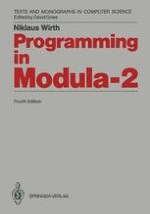1988 | OriginalPaper | Chapter
Sequential Input and Output
Author : Professor Niklaus Wirth
Published in: Programming in Modula-2
Publisher: Springer Berlin Heidelberg
Included in: Professional Book Archive
Activate our intelligent search to find suitable subject content or patents.
Select sections of text to find matching patents with Artificial Intelligence. powered by
Select sections of text to find additional relevant content using AI-assisted search. powered by
The usefulness and the success of high-level programming languages rests on the principle of abstractions, the hiding of details that pertain to the computer which is used to execute the program rather than to the algorithm expressed by the program. The domain that has most persistently resisted abstraction is that of input and output operations. This is not surprising, because input and output inherently involve the activation of devices that are peripheral to the computer, and whose structure, function, and operation differ strongly among various kinds and brands. Many programming languages have typically incorporated statements for reading and writing data in sequential form without reference to specific devices or storage media. Such an abstraction has many advantages, but there exist always applications where some property of some device is to be utilized that is poorly, if at all, available through the standard statements of the language. Also, generality is usually costly, and consequently operations that are conveniently implemented for some devices may be inefficient if applied to other devices. Hence, there also exists a genuine desire to make transparent the properties of some devices for applications that require their efficient utilization. Simplification and generalization by suppression of details is then in direct conflict with the desire for transparency for efficient use.
